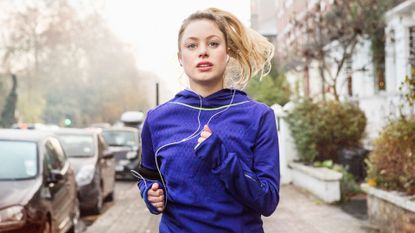Bouncing along the cycle path mid-way through my five kilometre run I noticed something astonishing, I hadn’t used my mouth to breathe, once.
‘How can this be?’ I thought. I usually run with my mouth so wide open, gasping for my life – luckily I can’t hear the terrible racket I’m making with my headphones in –that I’ve swallowed a few flies on a couple of occasions. Yet here I was, still alive and running.
More to my surprise, when I looked at my fitness tracker I was only three seconds slower than my previous run, despite having stopped multiple times for cyclists. So, I tried it again the following week – this time I was 52 seconds quicker, my fastest run this year. But how?
The benefits

Despite my unintentional efforts to do it myself, nasal breathing seems to be popular at the moment. Why though? Many of us will instinctively breathe through our nose and mouth whilst running. After all, it only makes sense that we want to try and take as deep a breath as possible whilst pushing our bodies. But, according to Lewis Paris, Founder of Lewis Paris Fitness, there’s two main reasons for nasal breathing. The first is to improve aerobic capacity.
“Improving the ability to inhale oxygen over a long period of time ensures a more comfortable run,” says Lewis. “The main focus when running long distances (alongside fuelling adequately) is to be able to provide the muscles with enough oxygen to produce energy, reduce fatigue and prolong lactic acid build-up.”
The second reason, he says, is to help control our heart rate. “Controlling your heart rate during your runs will help to manage the energy you burn and reduce the likelihood of burnout,” explains Lewis. “The higher the heart rate the less oxygen you'll inhale due to the shortness of the breath, compared to deep controlled breathing.”
Need for speed
My speed and quality of running had clearly improved since switching over to nasal breathing, but is this possible? Lewis says it is. “Nasal breathing can not only help you run faster but run for longer. With consistent nasal breathing on your easy runs, your lung capacity will increase and your diaphragm will get stronger which will mean more oxygen intake overall.”
A recent study published in the Journal of Kinesiology & Sports Science, led by scientists at Colorado State University also suggests this. The sample size was small and looked at 10 recreational runners (five men, five women), but their speed, as well as distance, both improved with the technique. However, the participants had been practicing nasal breathing themselves six months prior. Nevertheless, it still demonstrates its benefits when practiced.
How I did it

I’d say both my runs were a 70-30 split of nasal breathing to mouth and nasal breathing. However, my first run was significantly easier than my second run, most probably because I was doing it subconsciously, so I wasn’t overthinking it.
Relaxing is what I found helped the most. In that first run, as soon as I realised that I hadn’t breathed through my mouth, what did I do? I breathed through my mouth. During my second run, because I was trying so hard not to use my mouth, I found myself beginning to experience air hunger (feeling breathless and having a strong urge to breathe). To counteract this, I decided to try 10 to 15 nasal breaths, followed by three with my mouth. This kept my breathing much steadier.
I also kept my lips pursed together really tightly, so no air could get in, or escape. I looked stupid, but I found the more I relaxed my mouth the more tempted I was to open it, whereas if I kept it firmly shut I was forced to focus on how I was breathing through my nose. I'd try distracting myself with something on my run whilst doing it, like taking in my surroundings.
I've also tried breathing through my nose more daily too. Like with anything that you aren't good at, you have to practice. I'm aware that, as someone who runs once a week, I can't rely solely on a single weekly run to improve my nasal breathing and need to make efforts elsewhere.
I’m not a pro runner by any means and, who knows, maybe my runs were just 'lucky'. But switching to nasal breathing is the only change I've changed and this is how I've done it. Long may it continue.
Here's a couple of other tips from Lewis to help you with nasal breathing...
- Get comfortable with breathing through your nose daily. Be conscious of your breath and your movement. When you're aware you tend to be more in control leaving you less likely to panic. Notice how you breathe when at rest or walking, start with a closed mouth and control your breath here.
- Taping your lips together can encourage you to keep your mouth shut and train yourself to breathe through the nose at night.
- Take a generous sip of water when doing a workout and try to work out with the water still in your mouth. This will encourage you to keep your lips sealed and learn how to manage your breathing through your nose during exercise.



